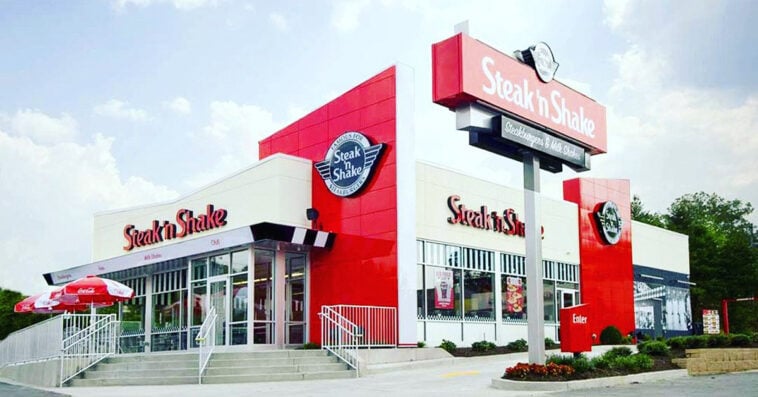Once a go-to stop for burgers and shakes along America’s highways, Steak ‘n Shake has hit some rough patches—including the closure of 200 locations in recent years. But the over 90-year-old chain isn’t ready to fade away just yet. By shaking things up with new strategies, modern tech, and a return to the classics that made it famous, Steak ‘n Shake is proving it can still hang with the fast-food big leagues. Read on to take a closer look at how this iconic brand is trying to reclaim its place in the spotlight.
Steak ’n Shake’s humble beginnings
Steak ’n Shake first opened its doors in 1934 in Normal, Illinois, marking the start of a legacy that would span over nine decades. The name itself tells the story: “Steak” represents the chain’s signature Steakburgers, while “Shake” highlights its hand-dipped milkshakes, a combination that has become iconic over the years.
The chain was the brainchild of Gus Belt, who was determined to serve the highest-quality burgers and shakes his customers had ever tasted. To prove the freshness and quality of his meat, Belt famously brought in barrels of steaks—including round, sirloin, and T-bones—and ground them into burgers right in front of diners. This commitment to transparency and quality gave birth to the chain’s enduring slogan: “In Sight It Must Be Right.”
Over the years, Steak ’n Shake steadily grew. By the 1990s, the chain had expanded to roughly 300+ locations across the U.S. Its growth continued into the 21st century, reaching a peak of about 628 restaurants in 2017, cementing its status as an American fast-food staple.
Steak ’n Shake’s bumpy ride
While Steak ’n Shake built a legendary reputation over nine decades, the path hasn’t always been smooth. QSR and FSR Magazine Editorial Director Danny Klein recently took a close look at the chain, revealing just how bumpy the ride has been.
“As you’d imagine, this hasn’t always been a smooth journey. Sales have been rocky. Management was overhauled. Units continued to shutter,” Klein wrote.
After Biglari Holdings took over in 2008 following financial losses, Steak ’n Shake operated around 500 locations. By 2018 and 2019, sales had slipped, and nearly 100 stores closed or were temporarily shuttered for franchise conversions, reducing the total from a peak of 600 to 500. The pandemic in 2020 accelerated closures and pushed locations below 550. Debt restructuring in 2021 prevented bankruptcy but left the chain with roughly 400 restaurants. Between 2022 and 2024, Steak ’n Shake continued with a smaller footprint—about 300 to 416 locations—still navigating financial pressures.
One of the boldest changes was dropping table service. While it helped save money, it also altered the experience. Once known for serving elevated, value-priced meals, the chain now feels closer to a standard fast-food restaurant, which affects how customers perceive its value.
Another major move was adopting a Chick-fil-A-inspired franchise model.
“It also implemented a franchise-partner model where single-unit operators pay a low upfront investment ($10,000) to take on a store and split the profits with corporate —the idea being to remove absentee ownership from the system,” Klein shared.
How Steak ’n Shake is bouncing back
Despite the setbacks, Steak ’n Shake is showing it can still adapt. After years of closures, debt troubles, and tough operations decisions, Steak ’n Shake is finally showing signs of life again. The brand that once looked like it might fade into fast-food history has started to grab headlines with some bold—and sometimes controversial—moves.
One of the most attention-grabbing changes was bringing back beef tallow for frying its French fries. The decision stirred debate but also reignited interest in the brand in a way it hadn’t seen in decades. On top of that, Steak ’n Shake leaned into buzzworthy marketing by becoming one of the first fast-food chains to accept Bitcoin as payment. Some critics dismissed it as a stunt, but it worked—the chain was back in the conversation.
“Whether it’s changes maturing or Steak ‘n Shake gaining publicity (and customers) from some of its recent moves, like going to beef tallow or accepting Bitcoin payments, same-store sales have started to climb. The brand said comps gained 10.7% in Q2. They were up 3.9% in Q1 and 5.4% in Q3 2024. The comparable Q2 2024: 7%,” Klein noted.
Financial results tell the same story. According to QSR Magazine, the company’s operating earnings nosedived from $34.717 million in 2016 to just $431,000 in 2017, then went negative for three straight years with losses of $10.657 million, $18.575 million, and $4.587 million. But by 2021, Steak ’n Shake was back in the black with $13.525 million in operating earnings, followed by $11.478 million in 2022. The recovery accelerated with $26.170 million in 2023 and $20.099 million in 2024.
The momentum has carried into 2025. “Net sales for Q2 and the first six months of 2025 were $46.8 million and $88.47 million, respectively, representing an increase of $6.043 million or 14.8% and $8.9 million or 11.2%, compared to prior-year results,” the company shared.
Steak ’n Shake’s journey shows that a legacy brand can still thrive in a fast-changing dining landscape. From its early beginnings, grinding fresh steaks in front of customers, to embracing bold moves like Bitcoin payments, the chain is proving it can adapt without losing its identity. With sales and earnings back on the upswing, it looks like Steak ’n Shake is setting the stage for a new chapter, positioning itself as both a classic comfort stop and a forward-looking player in the fast-food space.
Source: The Street, QSR Magazine

